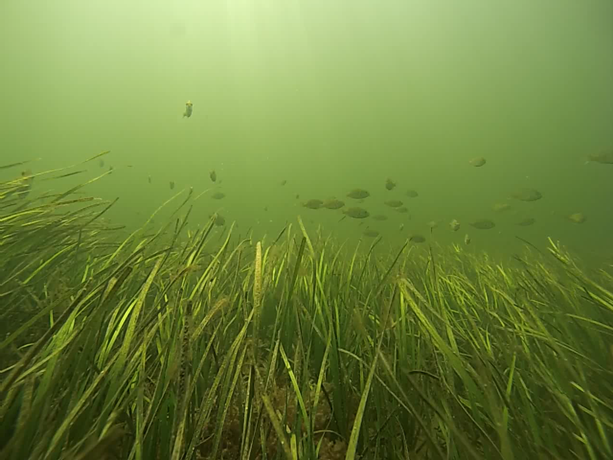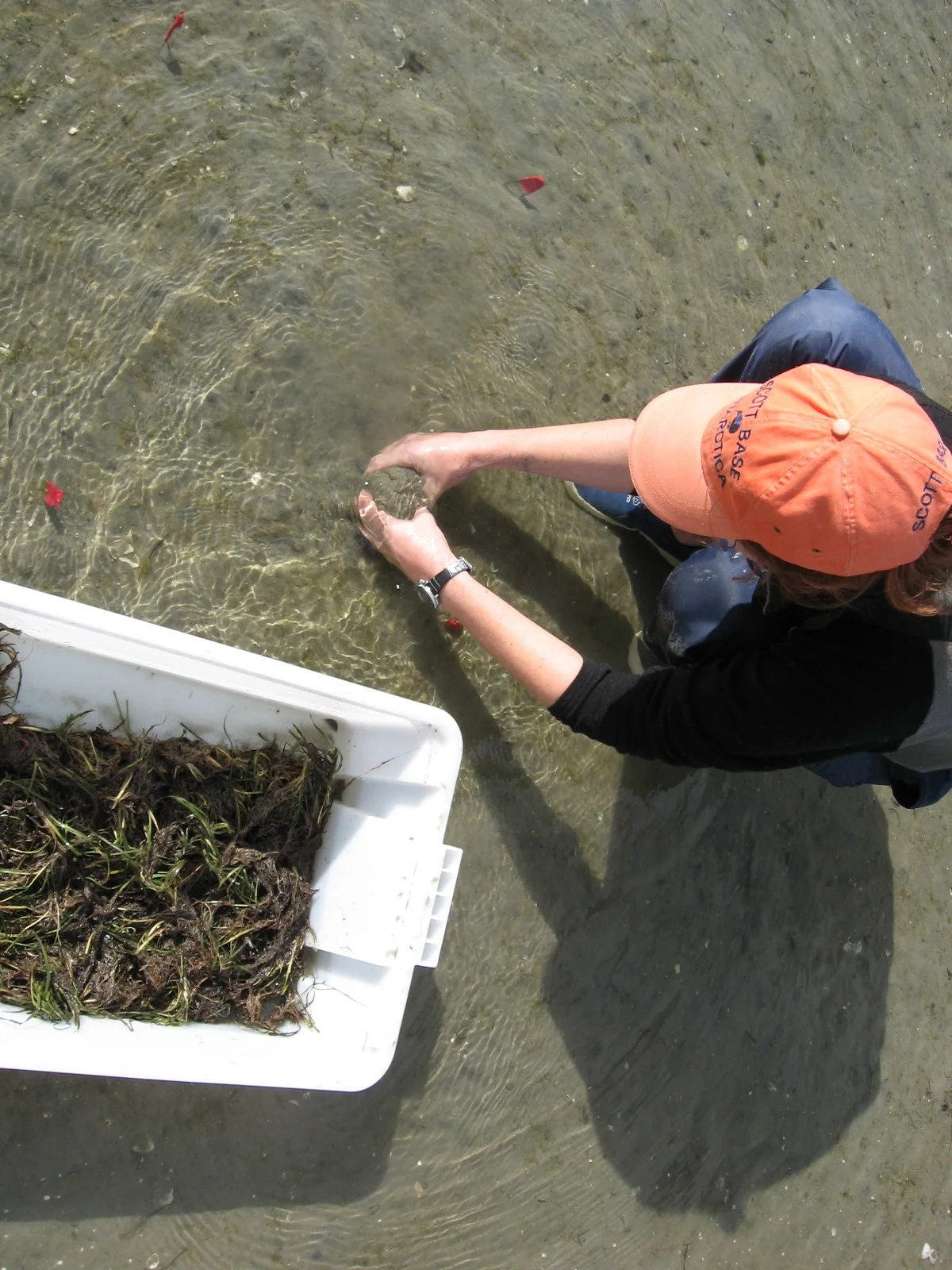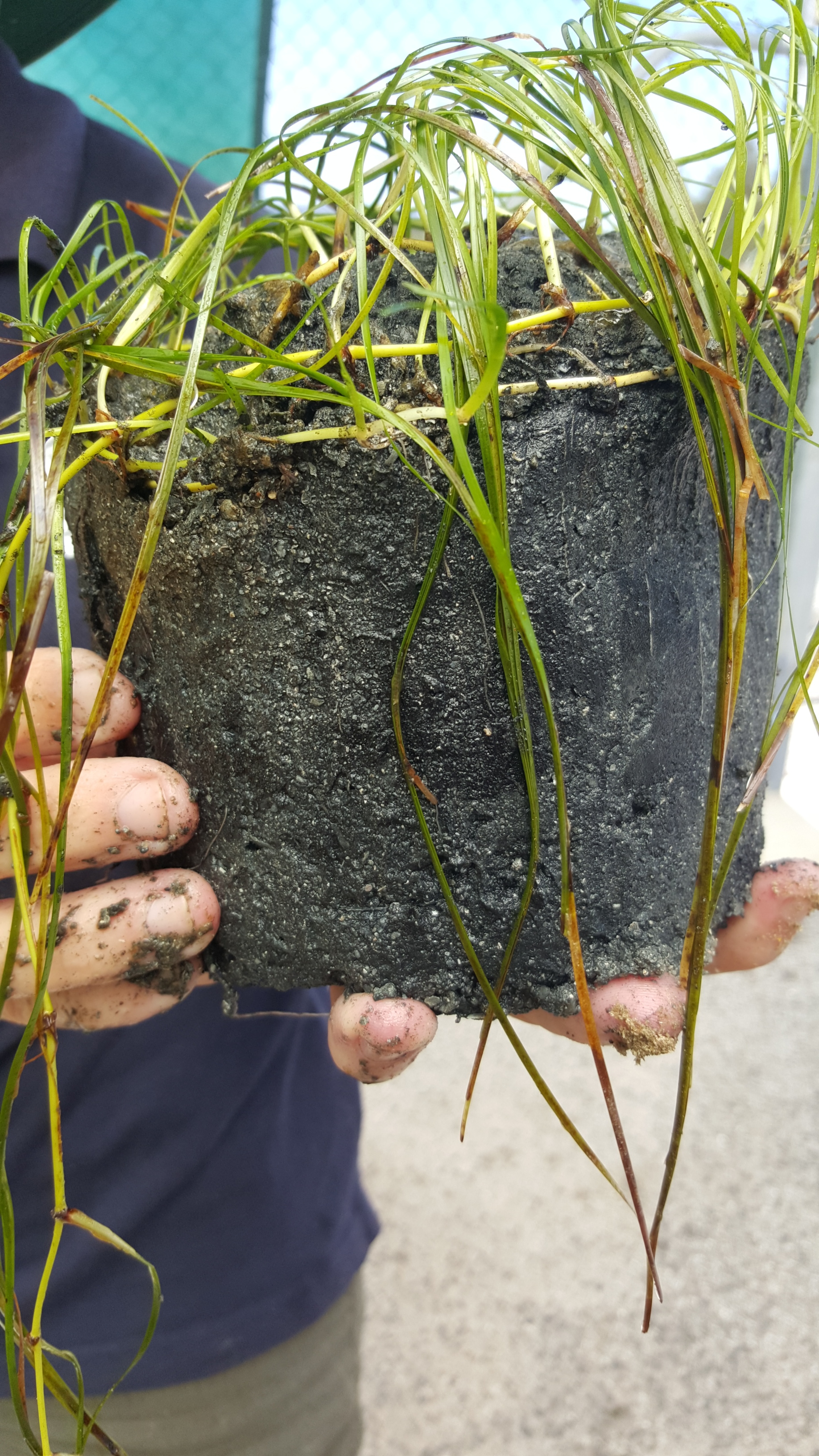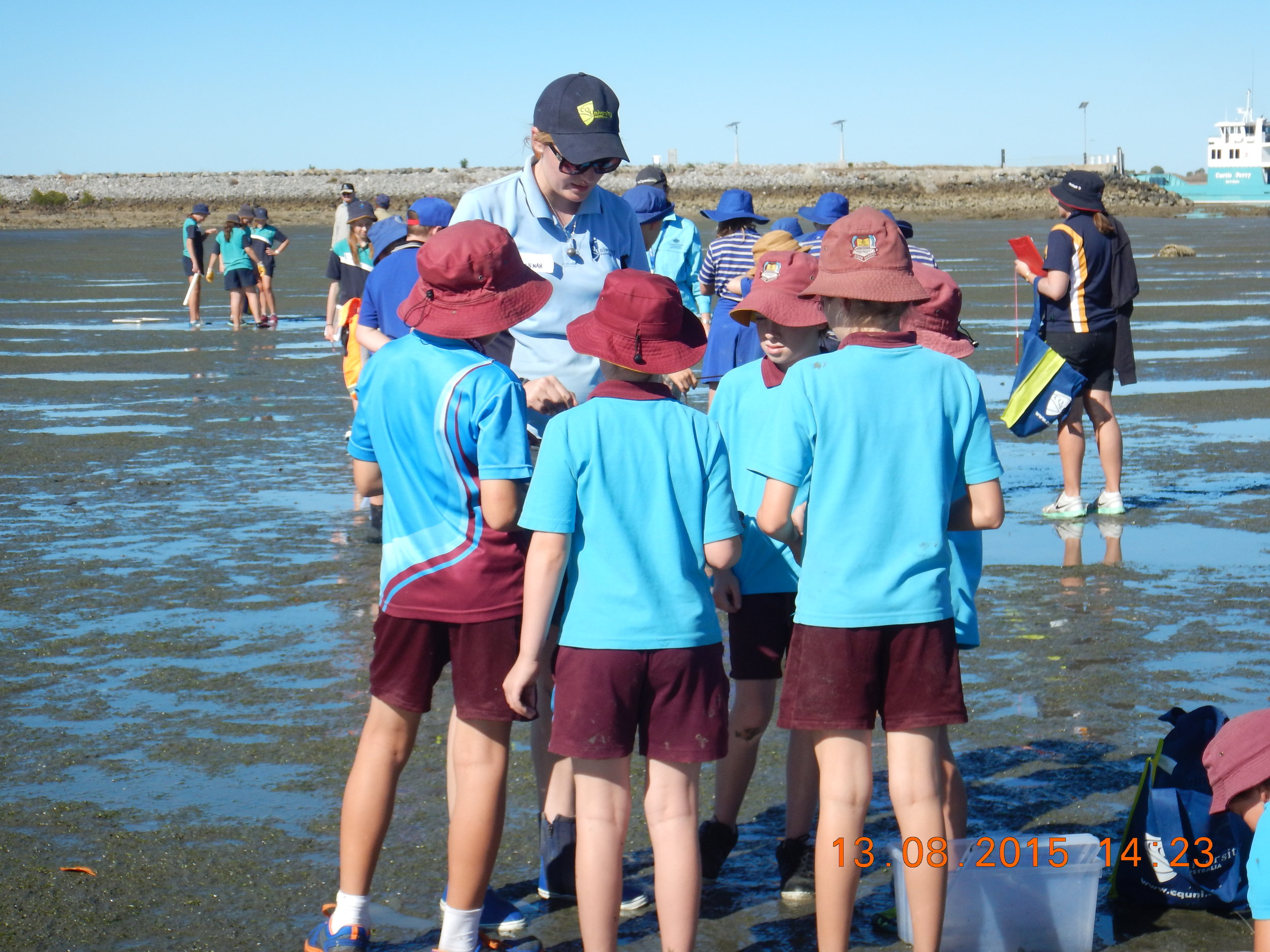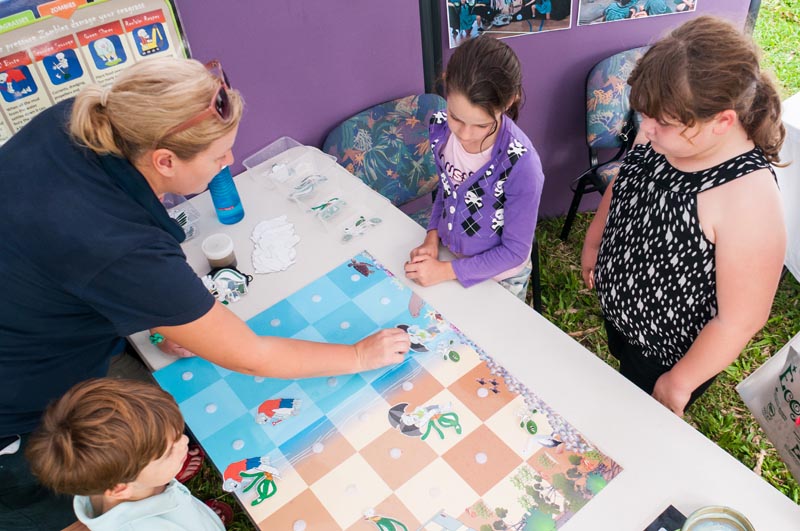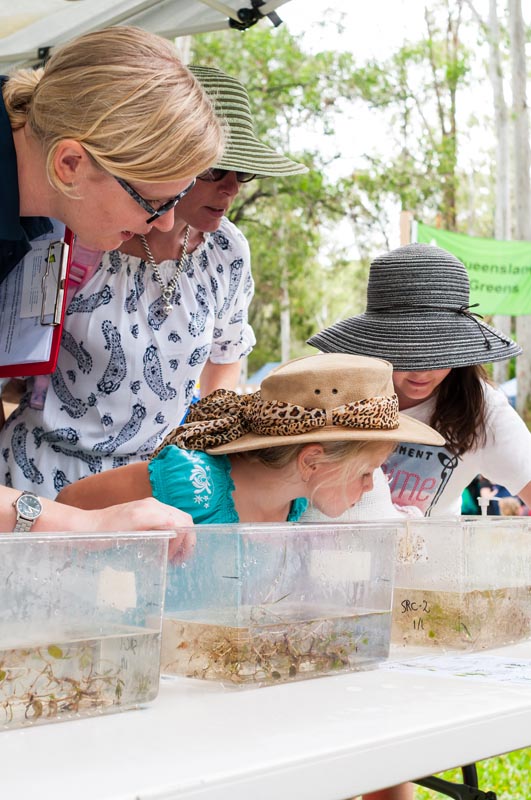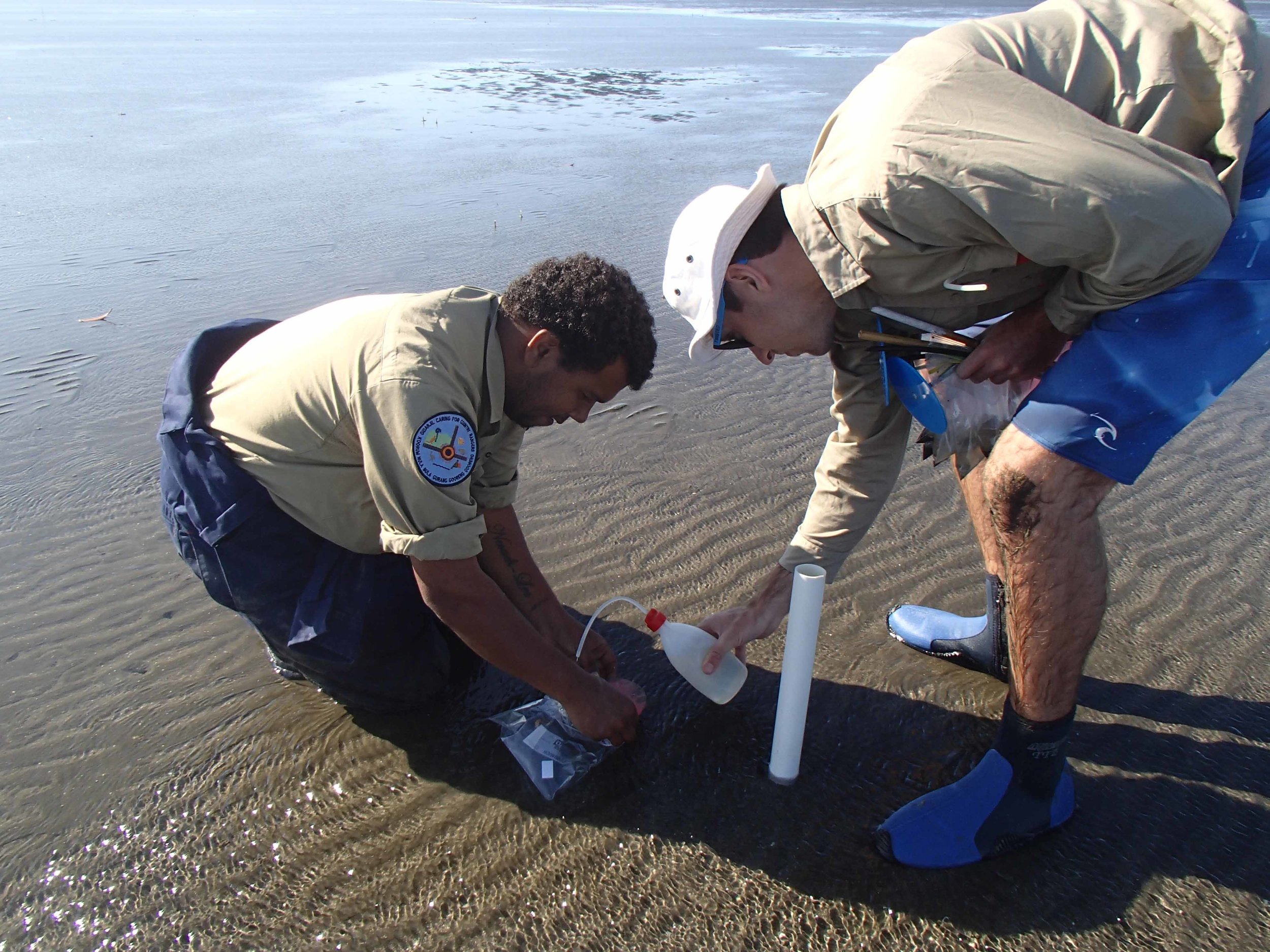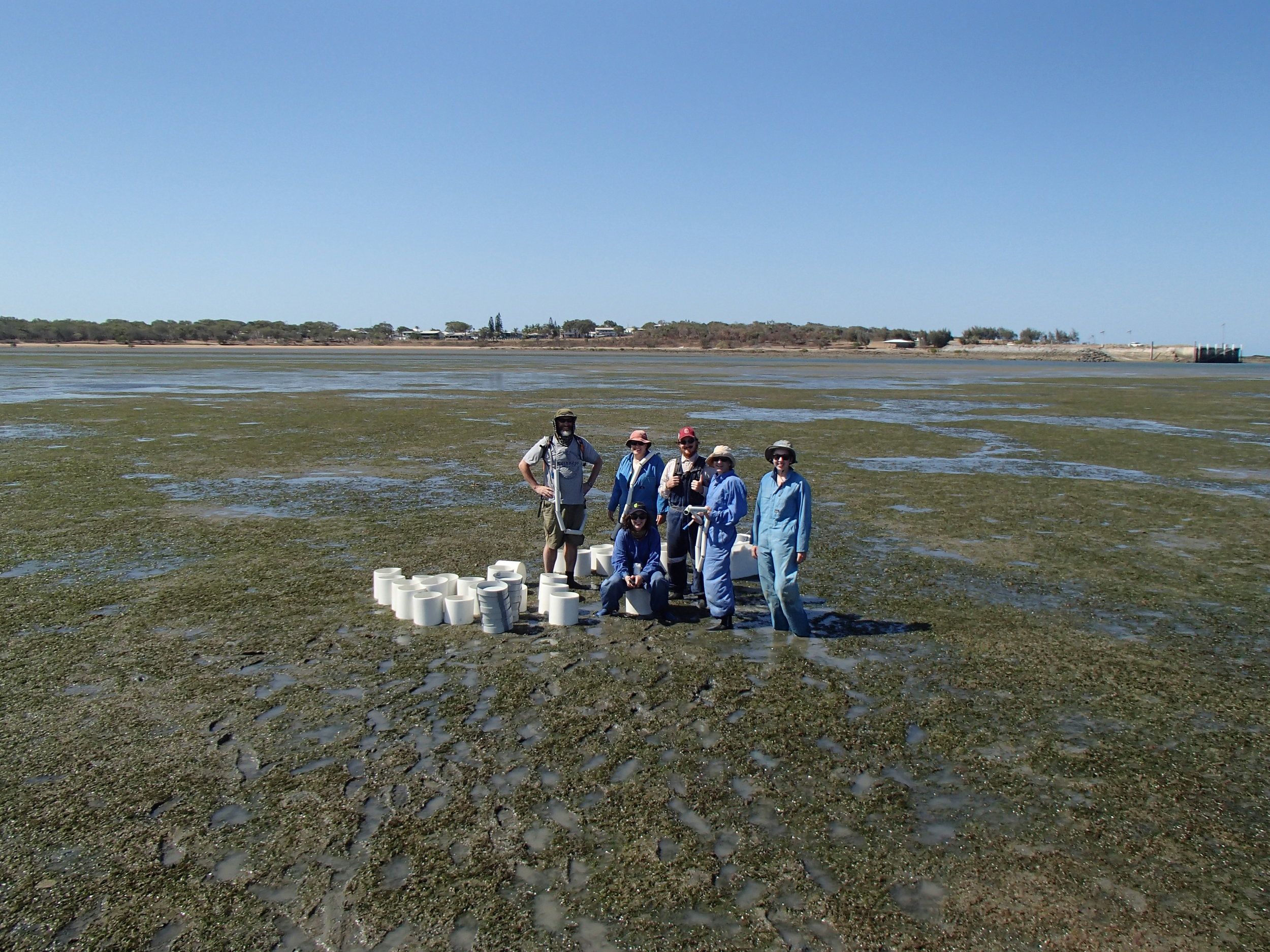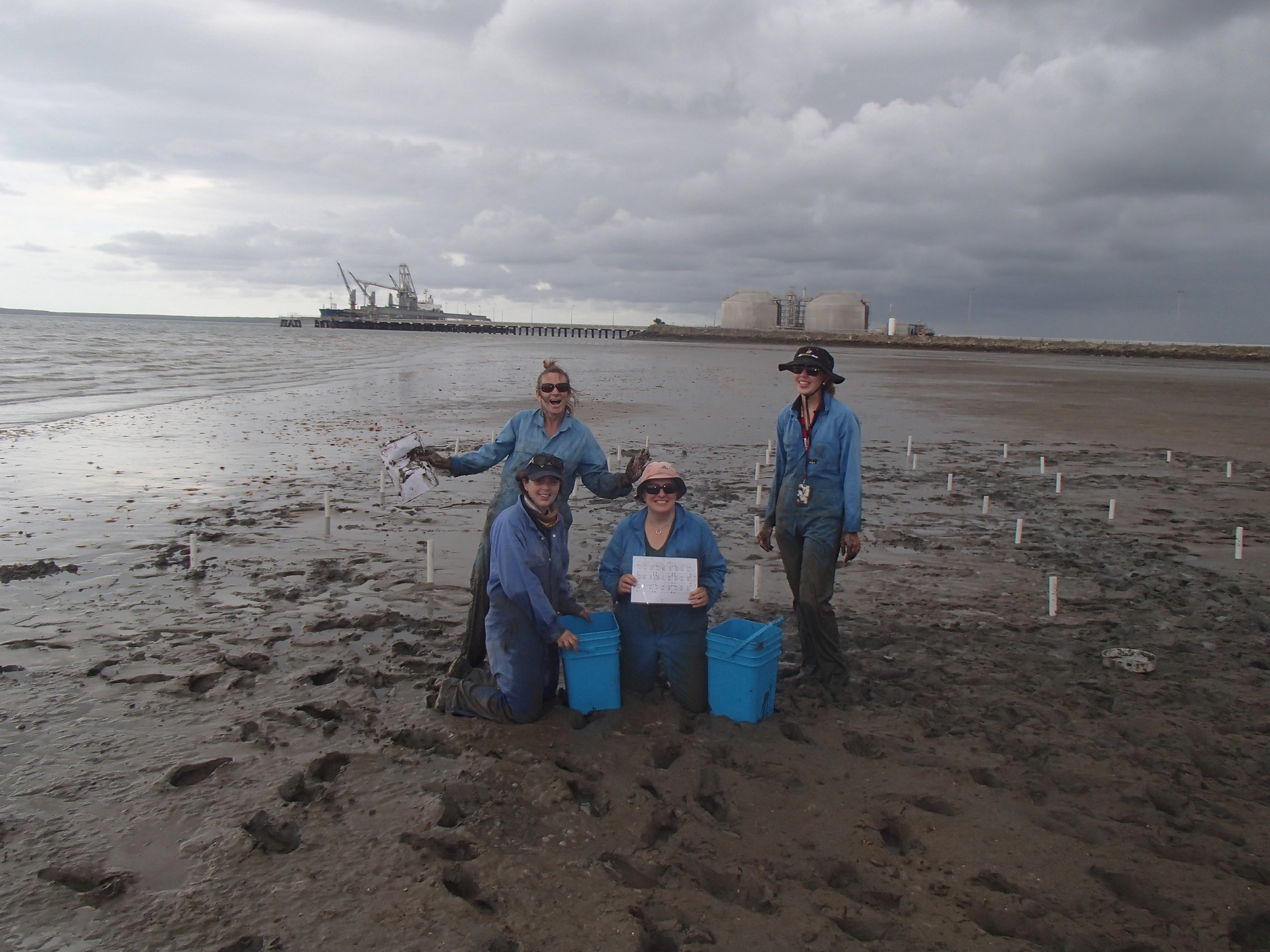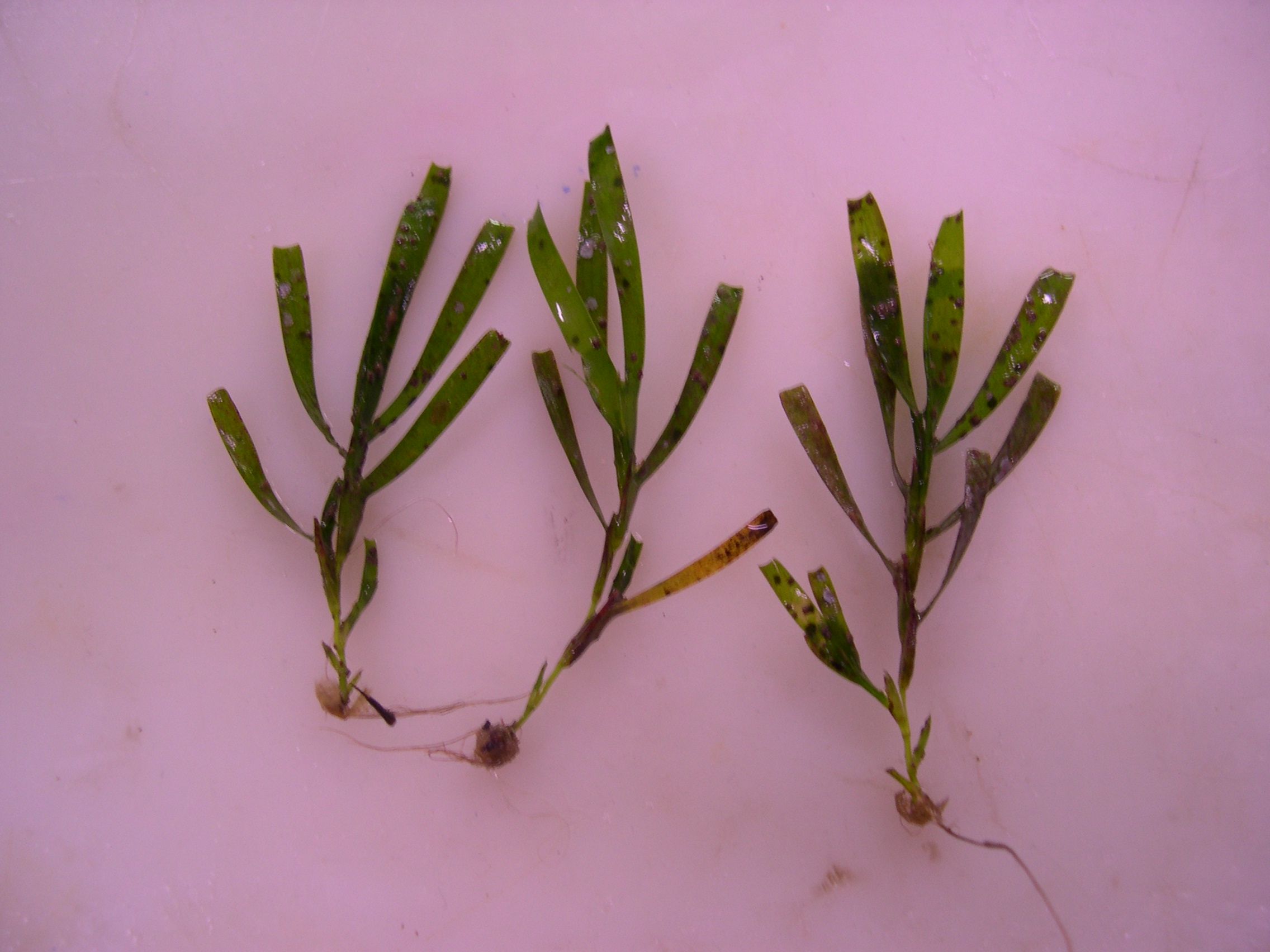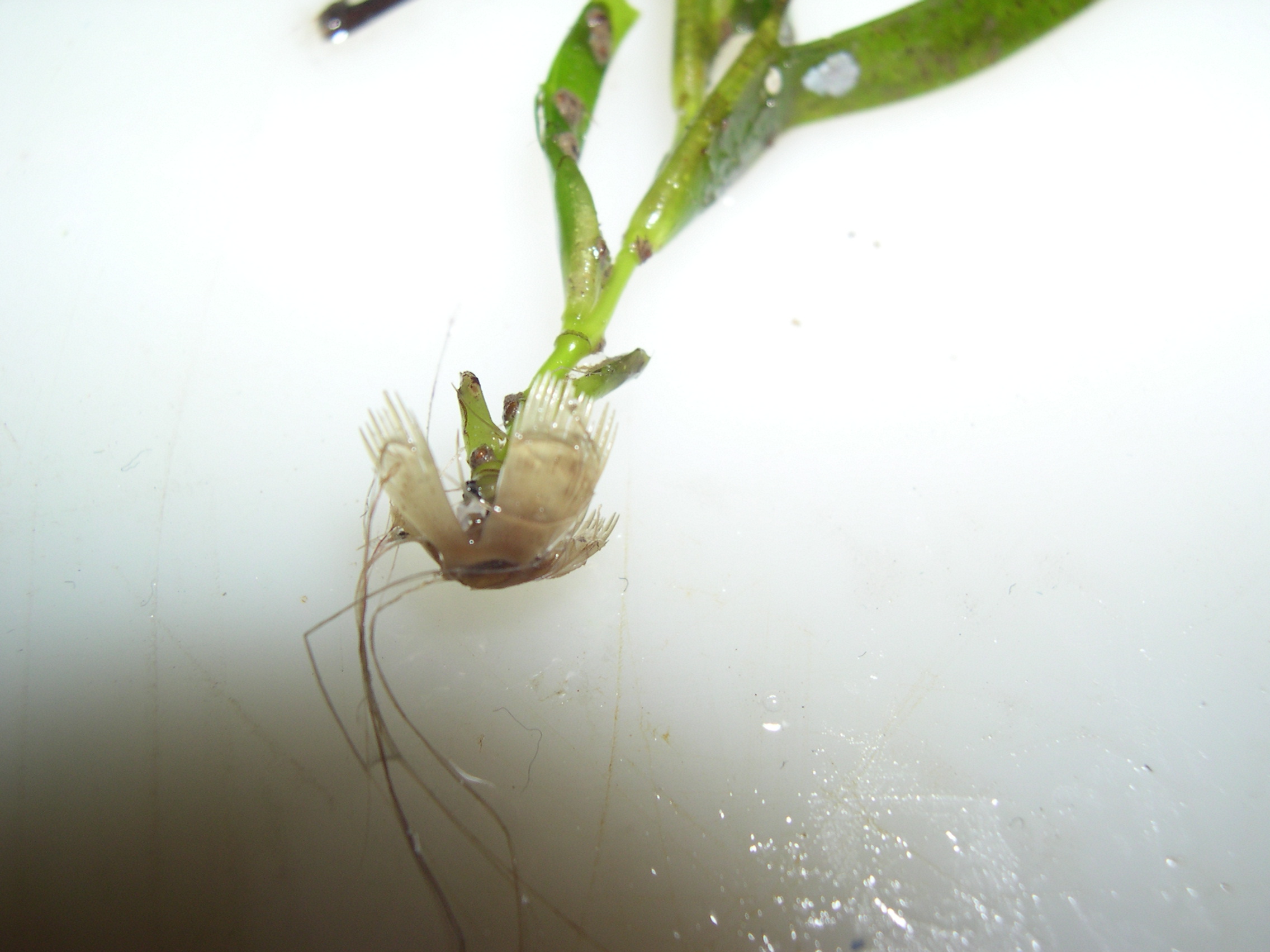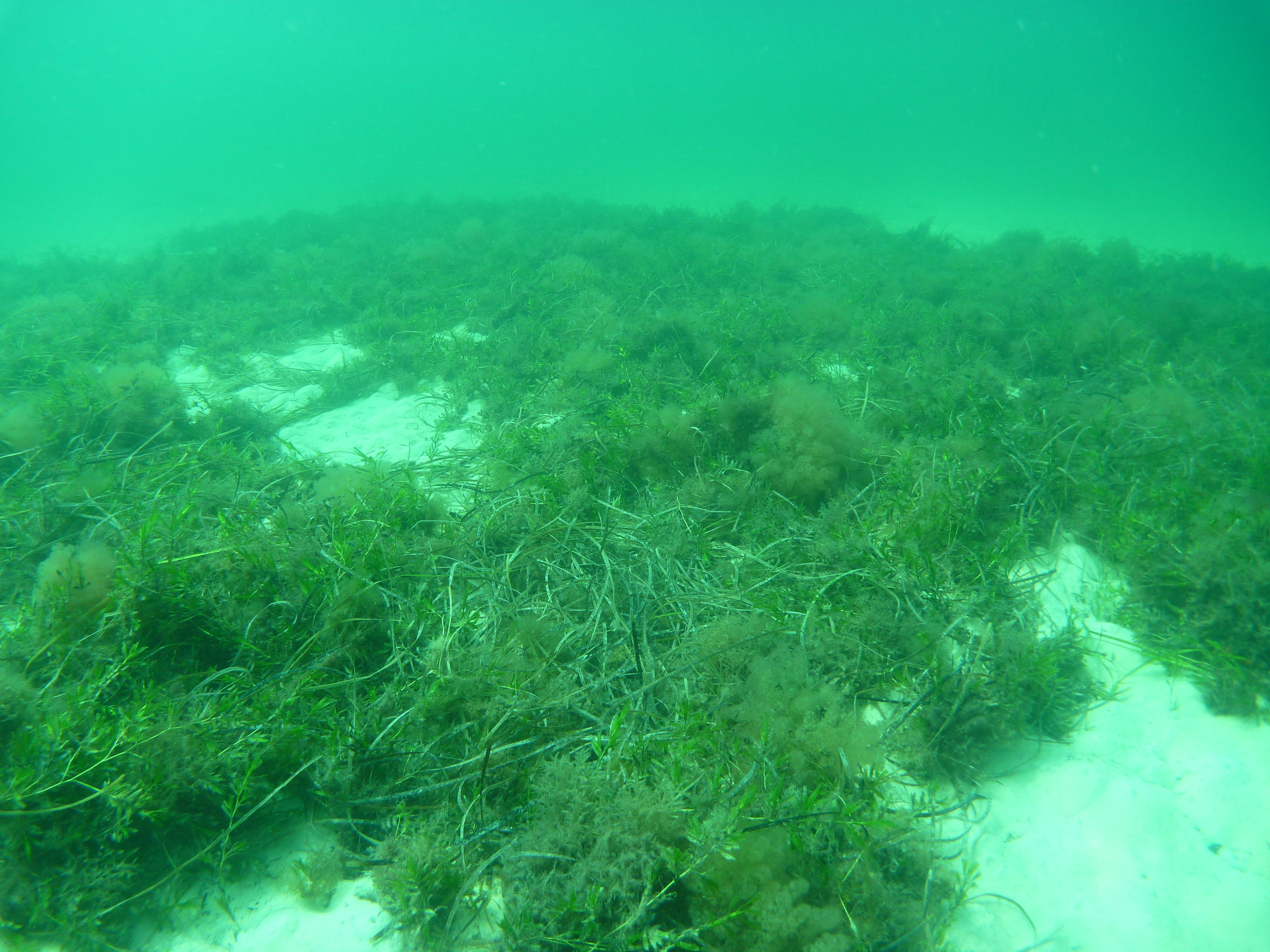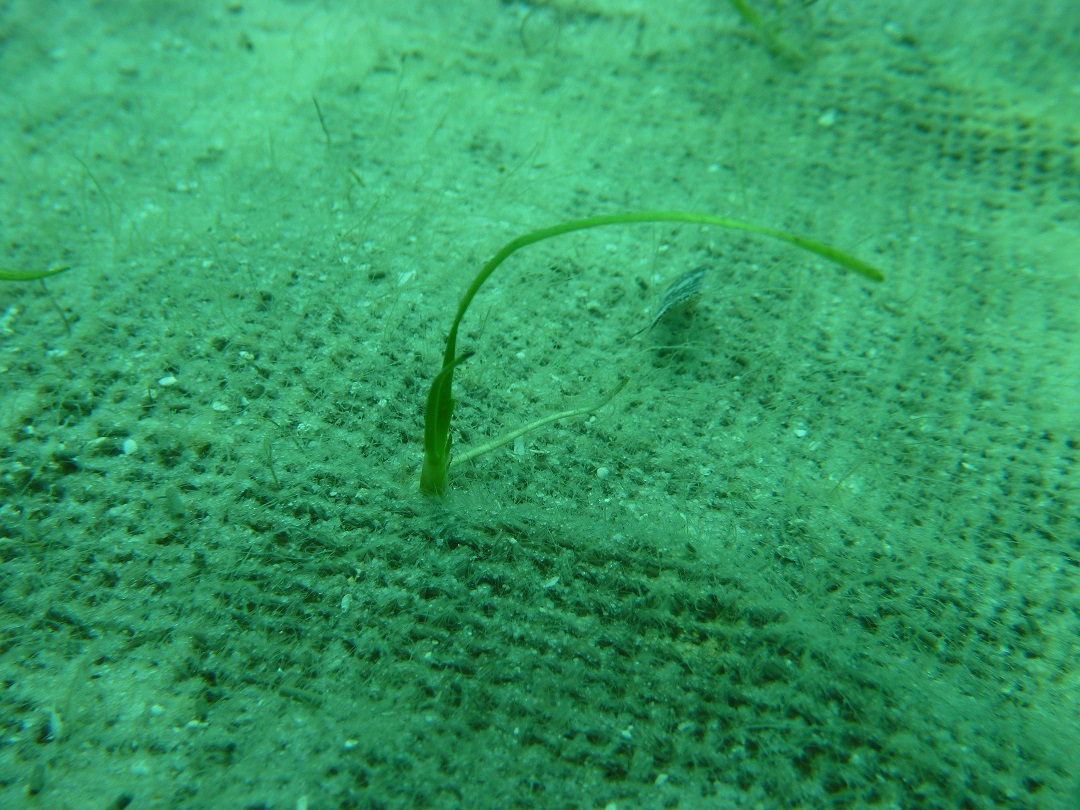
Seagrasses (marine flowering plants) are one of the most important carbon capturing and storing (carbon sequestration) habitats. Globally, we have lost over one quarter of seagrass coverage and therefore we have lost a substantial capacity to sequester carbon from the atmosphere. One method to regain this carbon sequestration capacity is to re-plant or re-seed seagrasses back into denuded areas – a form of carbon farming but underwater!
Oceans Institute researcher Dr John Statton from Plant Biology was approached by South Fremantle Senior High School teacher Julie Miller to teach and work with students on an underwater carbon farming project.
South Fremantle Senior High School grabbed Australia’s attention a few years ago when they announced they had successfully implemented a Carbon Neutral Project (beginning in 2007), and subsequently became the first ‘carbon neutral’ school in Australia. They achieved this by (i) reducing fossil fuel use, (ii) implementing renewable energy projects and (iii) capturing carbon emissions through tree planting.
The underwater carbon farming project (see weblink below) aimed to teach students (year 11), who were all Rescue SCUBA-diver qualified, the rigours of designing and implementing a scientific research project, working under-water with seagrasses, and working under-water as a team. The re-planting project was located in Jervoise Bay, Western Australia in 3 meters water depth and focussed on teaching the students how to identify, collect and process the seagrass Posidonia australis or ribbon-weed, and plant shoots within two contrasting habitat types; bare sand and remnant seagrass matte (fibrous material left behind after seagrass dieback). One year on from the initial planting, some of our shoots were present.
“The under-water carbon farming project provided the students with a sense of achievement once the planting was completed and fostered the appeal of under-water research and it’s potential for helping humanity”.
Seeds, an emerging approach to seagrass restoration
JOHN STATTON
UNIVERSITY OF WESTERN AUSTRALIA
Although seeding is a common technique in terrestrial restoration programs, it is a relatively new concept in seagrass habitat restoration. Given the massive scale of seagrass losses, development of scalable techniques is becoming increasingly necessary in order to tackle seagrass restoration programs at hundreds to thousands of hectares. In addition, seeds add versatility to current practices, emerging as an alternative and potentially cost-effective approach for replanting large areas and in difficult locations.
Researchers from the University of Western Australia (Prof. Gary Kendrick and Postdoctoral researcher Dr. John Statton) were awarded successive ARC linkage grants (2013 and again in 2016) partnering with local and regional industry (Cockburn Cement, BMT Oceanica, Shark Bay Salt) and authorities (Rottnest Island Authority) which fostered ongoing collaborations with world renown restoration ecologists, Prof. Kingsley Dixon from Curtin University and Botanic Gardens and Parks Authority as well as Prof. Robert Orth, an international expert in seagrass restoration ecology from Virginia Institute of Marine Science in the US.
Our approach follows the rigors of terrestrial seed science, but adapted to an underwater environment. We have been successfully developing approaches to (i) streamline techniques for seed collection and processing to improve the availability of large quantities of viable, ‘restoration ready’ seeds, (ii) deliver large quantities of seeds remotely to the seafloor, thereby enhancing the scale of seeding and improving our ability to restore locations that are difficult to access (deep, turbid, turbulent, or diver-restricted locations), and (iii) identify and overcome critical environmental factors militating against seedling establishment post-delivery to the seafloor.
Currently, a two-year pilot-scale seeding trial has established seedlings to the juvenile stage (2 years old) with 1-2 plants established every m2 and they are growing, producing new shoots with larger leaves (see figure and images below).
Figure: Collection, processing, delivery and establishment of Ribbon Weed (Posidonia australis) seeds in Cockburn Sound, Western Australia.
fig i
Mature clusters of fruit.
FIG iV
Clean seeds (no fruit husks) are
collected from the tank bottom
and held in aerated baskets.
FIG Vii
3-4 month old seedlings
FIG ii
100 litres of fruit (hand – collected 30 000 fruit in 4 hours),
FIG v
Seeds delivered to the seafloor via a broadcast seeding method (seeds scattered by a diver for precision or from a boat to maximise coverage).
FIG VIII
7 month old seedlings
Fig iii
Automated fruit processing – agitation from aeration causes fruit to split and seeds sink to the tank bottom, empty fruit are removed from the surface.
FIG VI
Seedlings with a developing shoot.
FIG IX
1 year old seedlings
producing new shoots
SEAGRASS TRANSPLANTS CONTRIBUTE TO REGENERATING SEAGRASS IN WHANGAREI HARBOUR, NEW ZEALAND
FLEUR MATHESON
NATIONAL INSTITUTE OF WATER AND ATMOSPHERIC RESEARCH, NEW ZEALAND
Photo 1 Subtidal meadows of Zostera muelleri in Northern New Zealand are important nursery habitat for fish stocks
(Photo: Mark Morrison).
Photo 2 Transplanting “sprigs” of Zostera muelleri into 0.25m2 experimental plots on the Takahiwai sandflats, Whangarei Harbour, in April 2008
(Photo: Jacquie Reed).
ZOSTERA RESTORATION
Prior to the 1970s Whangarei Harbour in Northern New Zealand had extensive areas of intertidal and subtidal seagrass totally c. 1400 hectaresor or about 10% of the harbour (Reed et al. 2004). Amongst the vital ecosystem services provided by this primary producer, the subtidal meadows are nurseries for fish stocks with high commercial, recreational and cultural value, including Australasian snapper (Pagrus auratus) and trevally (Pseudocaranx georgianus) (Photo 1). The seagrass meadows here and elsewhere in NZ are composed of one species, Zostera muelleri (syn. Z. capricorni, Z. novazelandica).
In the late 1960s, the seagrass meadows in Whangarei Harbour underwent a dramatic decline due to human activities so that, several decades later, only small remnants remained (Reed et al. 2004). However, changes to industrial discharge and harbour dredging practices during this time enabled an apparent improvement in harbour water quality, whereby the remnants appeared to begin a slow expansion.
In April 2008, Northport, local Māori, the Northland Regional Council and NIWA, through the Whangarei Harbour Health Improvement Fund, initiated a trial to transplant seagrass from the largest remnant (c. 5 ha) at One Tree Point to the Takahiwai sand flats, an area with past extensive seagrass meadows. The 2 year trial was quite successful. Three transplanting methods were tested and two of these (using “sod” and “sprig” units) worked very well (Photo 2). The unsuccessful method was planting sprigs amongst mats of artificial seagrass, which did not enhance conditions for growth as expected. The donor site recovered rapidly (Photo 3). At the conclusion of the trial not only had all of the sod and sprig transplants survived and flourished but an extensive area of seagrass, many tens of hectares in extent, including the subtidal zone, had regenerated across the Takahiwai sand flats (Photo 4). Local Māori in particular were pleased with this outcome and reported improved fish catches following the return of seagrass to this area (G. Pirihi, Takahiwai, pers. comm).
Photo 3 Local volunteers monitoring seagrass recovery at the One Tree Point donor site, Whangarei Harbour, in October 2009
(Photo: Fleur Matheson).
Photo 4 The regenerated seagrass meadows on the Takahiwai sandflats, Whangarei Harbour, in April 2013 (Photo: Crispin Middleton).
Photo 5 Zostera muelleri transplants at McDonald Bank, Whangarei Harbour, in July 2016, which have spread slowly and steadily since planting four years earlier (Photo: Crispin Middleton).
Another two years on, in July 2012, a second trial was initiated to try and reestablish seagrass at another important former site, McDonald Bank, one of several large offshore sand banks in the harbour, using the newly regenerated Takahiwai meadows as a donor site. Four years on, this trial has also been quite successful. All of the four planting configurations tested, from planting a cluster of five small seagrass cores (10 cm diameter) to larger plots of 0.5 m2, have been comparably effective. Virtually all of the 24 transplant units have gradually spread to occupy c. 25 to 35 m2 each, and a total area of c. 750 m2 (Photo 5). We anticipate that this slow and steady expansion will continue.
Within the harbour as a whole, seagrass has now re-established at a number of its former sites of occupation.
We estimate it now occupies c. 40% of its former range.
These trials have demonstrated that it is possible to successfully transplant this species of seagrass to enhance the natural “restoration” process, once the conditions responsible for its past demise have been ameliorated to a sufficient extent.
References
Reed J, Schwarz A, Gosai A, Morrison M (2004) Feasibility study to investigate the replenishment/reinstatement of seagrass beds in Whangarei Harbour – Phase 1. NIWA Report for Northland Regional Council, 22p.
Morrison MA, Lowe ML, Grant C, Smith PJ, Carbines G, Reed J, Bury SJ, Brown J (2014) Seagrass meadows as biodiversity and productivity hotspots. New Zealand Aquatic Environment and Biodiversity Report No 137. Ministry for Primary Industries, Wellington, 147p.
Seagrass restoration in Oyster Harbour, Western Australia
Geoff Bastyan AND Marion Cambridge
UNIVERSITY OF WESTERN AUSTRALIA
The decline of seagrass meadows is a common and widespread problem throughout the world, but strong recovery seems to be happening in the Albany Harbours region on the south coast of Western Australia. Almost 90% of the seagrass disappeared in just a few years in the early 1980’s in Oyster Harbour, coinciding with a buildup of masses of green algae after extensive changes in land use within the catchment area.
Aerial photograph (October 2001) showing details of the Posidonia seagrass transplant plots in Oyster Harbour, Albany, after 3.6 years growth.
Transplant plots were 10 x 10m and approximately 10m apart. Individual transplant units were planted 1m apart. The regular circles are seagrass approx. 12 years old that grew back from remnants of the original meadow.
Aerial photograph (March 2011) showing progress over a decade. Individual plants spaced 1m apart were still visible after 3.6 years, but by 7 years, plants in each plot had grown together to form a continuous dense meadow.
The rectangular shape of the 10x10m plots was still evident but by 11.5 years, even the spaces between some of the plots, originally spaced 10m apart, were being vegetated.
By the mid 1990’s, there seemed to be some improvement. Geoff Bastyan began a small study in 1994 to assess the feasibility of transplanting the seagrass, Posidonia australis, into areas once vegetated by seagrass meadows. The success of the pilot study prompted a second, more comprehensive series of trials at the same site two years later in 1996, to assess whether results for survival and growth were repeatable and to compare growth of planting units taken from the edges versus centres of seagrass meadows. Observations of P. australis suggested that most growth occurred during spring and summer, so the trial in Oyster Harbour was extended in the following spring to examine the effect of planting at the beginning versus the middle of the growing season.
These restoration activities have now been running for 20 years. The original 10 x 10 meter plots of transplanted seagrass, which showed up so clearly in aerial photos taken 3.5 years later in 2001, have now coalesced into a continuous dense meadow. Fruit were produced from the transplants four years after planting, and together with natural horizontal growth of the transplants, have resulted in the infill and expansion of the original transplant plots.
Results for survival and growth, and a comparison of growth of planting units taken from the edge versus centre of seagrass meadows, were described for the first 10 years in Bastyan & Cambridge (2008), and now after the first tentative pilot trial 20 years ago, broad scale recovery seems to be well underway and will be reported on in the near future. The successful seagrass restoration at Oyster Harbour highlights the time, dedication, and commitment required for restoring ecological systems.
Recognition of Geoff Bastyan’s commitment and determination
was finally acknowledged in 2014 with the UWA Oceans Institute ‘Southseas Oceans Hero’ Award,
followed by the Great Southern Development Commission medal in 2016.
Details of the transplanting technique were published in 2013: Transplanting Posidonia seagrass in temperate Western Australian waters: A practical ‘How To’ Guide. Available at: http://www.bmtoceanica.com.au/products/seagrass-transplanting-manual/
Reference
Bastyan GR, Cambridge ML (2008) Transplantation as a method for restoring the seagrass Posidonia australis. Estuarine, Coastal and Shelf Science, 79: 289-299.
Restoration of Ruppia tuberosa
in the Coorong
Kor-jent van Dijk and Michelle Waycott
DEPARTMENT OF ENVIRONMENT, WATER AND NATURAL RESOURCES, UNIVERSITY OF ADELAIDE
The Coorong is a permanent coastal lagoon that forms part of the terminal lake system at the River Murray mouth. It runs for 100km parallel to the sea and is an inverse estuary, with a constricted opening at the River Murray mouth. The Coorong is a unique ecosystem with a strong salinity gradient increasing from the north lagoon (estuarine/marine) near the mouth, to the southern lagoon, which is hypersaline (exceeding 200 g/L during the millennium drought).
The Coorong and Lower Murray Lakes were designated as a Wetland of International Importance under the Ramsar Convention in 1985, in recognition of its role in supporting a wide range of habitat types (estuarine, marine and hypersaline) and vast numbers (tens of thousands) of waterbirds, including ducks, swans, pelicans, terns, grebes, and migratory shorebirds.
Ruppia tuberosa is the dominant macrophyte in the Coorong, fulfilling the role of cornerstone species by providing food for waterbirds and habitat to a diverse fish community. R. tuberosa is able to withstand the extreme range of salinity, particularly the hypersalinity occurring in the southern Coorong.
R. tuberosa distribution and density declined in the southern lagoon between 2000 and 2010 (a period described as ‘the Millennium drought’) and it was completely absent in 2010. Very high salinity and low water levels are widely acknowledged as the main environmental causes for this loss of R. tuberosa. Salinity in the Lower Coorong reached a maximum recorded salinity of >200 TDS g/L in 2000 – 2010. After the millennium drought (2000-2010) the River Murray flows returned (late 2010) and water levels in the southern Coorong were appropriate again for R. tuberosa to grow. Ruppia tuberosa began to recover after the 2010-2011 floods in the southern lagoon and distribution increased in the years after with the adjusted water allocations. Even so, R. tuberosa did not closely recover to pre-drought densities.
Given the importance of R. tuberosa for the Coorong ecosystem a translocation program was established to facilitate its recovery. In autumn 2013 the program was started where R. tuberosa seeds were sourced from the margins of Lake Cantara and moved to recovery sites. With a small excavator, seeds were harvested by scraping a thin layer (~1.5 cm) of sediment (with seeds) from the dried-up lake margins during autumns of 2013 and 2014. The sediments were piled up on the banks and was shovelled by hand into sand-bags and transported to four recovery sites where the bags were evenly distributed over the donor-site and emptied. A total of 280 (14,080 bags) and 450 tonnes (30,100 bags) of sediment were translocated in 2013 and 2014 respectively. Bags were translocated to Policeman Point and Woods Well in 2013 and to Fat Cattle Point, Jacks Point and Seagull Island in 2014. An estimated area of around 20 ha and 41 ha were treated during the two restoration years. The restoration efforts were successful in that R. tuberosa did recolonize the areas transplanted.
While the restoration has helped recovery in the South lagoon, the process of recovery has been slow, and up until 2016 water levels have not been high enough to successfully complete the reproductive cycle. In particular, seed and turion density remain low compared to historical values. Ongoing monitoring of the system will identify if there is increased Ruppia recovery in the Coorong over longer time frames.
Figure 1. Ruppia tuberosa patch in shallow waters of lake Cantara.
Figure 2. Ruppia tuberosa flower with pollen being released.
Figure 3. Stages in the Ruppia translocation action 2014/2015, top LHS harvesting seeds in sediments at Lake Cantara, top RHS stores of sediments containing seeds, bottom LHS, placement of stored sediments on day of spreading and RHS, spreading actions.
AMPHIBOLIS RECOVERY IN SA
Facilitating natural recruitment to restore seagrass
Jason Tanner
SOUTH AUSTRALIAN RESEARCH AND DEVELOPMENT INSTITUTE AQUATIC SCIENCES
Since 1949, there has been a loss of 6,200 ha of seagrass from the Adelaide coast, primarily due to overgrowth by epiphytic algae that thrived as a result of anthropogenic nutrient inputs, and turbidity. In response to these losses, and efforts by both SA Water and the Adelaide and Mount Lofty Ranges Natural Resources Management Board to substantially decrease nutrient and sediment inputs, the South Australian Research and Development Institute, a division of Primary Industries and Regions SA, and the Department of Environment, Water and Natural Resources, held a series of seagrass restoration workshops, and began investigating approaches for seagrass restoration.
Initial efforts focused on adapting techniques used elsewhere, namely transplantation and the laboratory production of seedlings, however, success was limited. Observations during these trials suggested that the use of hessian to facilitate natural recruitment of Amphibolis seedlings may work. Subsequent work trialed a range of different deployment options in 2004, with a standard hessian sack filled with around 20 kg of sand being selected for most subsequent work. This bag can simply be dropped off a boat, and does not require any further manipulation by divers, making it easy and cheap to deploy.
An issue with early trials was uncertainty around the best time of year to deploy bags to maximise recruitment. Anecdotal evidence suggested late winter/early spring. In 2007-2013, a concerted effort to identify the timing of reproduction and recruitment was made, with bimonthly deployments of bags and collection of adult plants at four sites. May to August was the best period for bag deployment to maximise recruitment success, and Amphibolis structural characteristics (stem density and length) were similar to those in natural meadows five years after bag deployment. Interannual variation in recruitment was present, but relatively minor. Early deployments that had started to coalesce into larger patches in 2013 have now formed several larger patches where the locations of individual bags can no longer be distinguished.
One of the issues experienced has been the rapid deterioration of some batches of bags. To address this, a series of trials were undertaken with Flinders University to develop coatings that would increase their durability. While these trials showed some promising results, the logistics and costs associated with treating bags meant that this approach was not pursued further.
Not only do the bags provide a mechanism for the successful facilitation of Amphibolis recruitment, but the resultant Amphibolis patches appear to be providing a similar ecosystem function to natural seagrasses. Epifaunal richness and abundance reached that present in natural seagrasses one year after Amphibolis recruitment, although assemblage structure took three years, the same time as seagrass structure took to recover. Infaunal assemblages recovered within two years. Both Zostera and Posidonia seagrasses have recruited into patches of restored Amphibolis, and larger fauna such as syngnathids also utilise the restored habitat.
To extend the applicability of the technique to other seagrasses, trials were also conducted with Posidonia. Due to the different life-history strategy and morphology of the two genera, Posidonia had to be planted into the bags as seedlings by divers, as they do not naturally recruit to them. Seedlings planted in 2012 survived and grew well over the subsequent four years, and have produced multiple shoots.
Overall, sand filled hessian bags deployed at small-scales during winter are an effective means for rehabilitating patches of Amphibolis with minimal intervention, provided that there is a nearby source of recruits. Small-scale patches now appear to be functioning the same as nearby natural meadows. The focus now is on a series of one hectare scale trials, as well as examining how the handling of bags prior to deployment may affect their integrity.
Reference
Tanner JE, Theil MJ (2016) Adelaide Seagrass Rehabilitation Project: 2014-2016. Final report prepared for the Adelaide and Mount Lofty Ranges Natural Resources Management Board (PDF 2.6 MB). South Australian Research and Development Institute (Aquatic Sciences), Adelaide. SARDI Publication No. F2009/000210-2. SARDI Research Report Series No. 914. 43pp.
Seagrass restoration in south australia
securing the future of our coastline - south australia’s biggest seagrass restoration project
Department of environment and Water
The South Australian Government is undertaking the largest seagrass restoration project in Australia through a $1 million New life for our coastal environment project to re-establish around 10 hectares of seagrass off the Adelaide metropolitan coast.
Seagrass meadows are very important to the nearshore coastal environment. They help stabilise the seabed by holding sand with their roots and reduce the waves and currents near the seabed with their leaves. They also provide both food and habitat for marine life.
Over the last half century, around one third of seagrass along the Adelaide metropolitan coast has been lost.
While natural events such as storms can cause large-scale seagrass loss, the main cause of the initial seagrass loss was poor water quality resulting from drain discharge, stormwater run-off and effluent disposal.
Once destroyed, seagrass ecosystems do not easily recover as waves and currents erode the exposed seabed and inhibit regrowth.
As seagrass is not easily able to re-establish in bare sand, the seagrass restoration project uses a technique developed in South Australia of placing hessian bags on the sea floor to hold seagrass seedlings in place. By the time the hessian decomposes, many seedlings are sufficiently established.
Trials are being undertaken in 2019 between Largs Bay and Hove, to identify suitable sites for large scale restoration work in 2020. It will take several years for the seagrass to fully establish. The restoration will be monitored to measure and report on progress over time.
The project is being delivered by the South Australian Research Development Institute in partnership with our department and will inform future seagrass restoration work.
Operation Posidonia
Giulia Ferretto
UNIVERSITY OF NEW SOUTH WALES
Posidonia australis forms highly productive meadows in the southern half of Australia, from Wallis Lake in New South Wales to Shark Bay in Western Australia. In New South Wales Posidonia meadows are found mostly in shallow and sheltered bays, which are also preferred areas for humans to live. Increased coastal development and pollution has led to major declines of Posidonia over the last few decades.
The declines of Posidonia meadows in the central parts of New South Wales (NSW) have been so severe that six meadows have been formally listed as ‘endangered’ by the NSW government in 2012. The Australian Commonwealth Government subsequently listed Posidonia meadows as ‘threatened ecological communities’ in 2015 (EPBC Act, 1999). Unfortunately, there is a real risk that this species may become locally extinct from some of these estuaries within the next 15 years unless new conservation actions reverse current trends. To reverse this decline and prevent further losses, there are now strict regulations that limit coastal development near seagrass meadows, and water quality has greatly improved in the last couple of decades.
There are still some human activities that continue to be a problem and are still leading to the decline of Posidonia in some estuaries. Boat moorings are one of the most obvious current disturbances to seagrass habitats, as the sheltered bays where this seagrass naturally thrives are also the most ideal locations for people to moor their boats. The problem with traditional swing moorings, is that they have a heavy chain that scours the seafloor, removing seagrass shoots and associated marine life. This process causes the formation of sandy bare patches that fragment the meadow and over time, as the mooring scars get larger, bare patches start to merge, leading to more Posidonia losses. Alternative mooring designs now exist (so-called environmentally friendly moorings or EFMs), that do not have components dragging along the seafloor. Large scale transition to the EFMs could prevent ongoing damage to Posidonia. However, the natural revegetation of bare patches by Posidonia can still take decades, especially after large mooring scars have developed.
Representation of a traditional swing mooring (left) and an environmentally friendly mooring (right). Photo Credit: Catfish Creative.
A healthy meadow of Posidonia australis (left) and meadows fragmented by swing mooring scars in Shoal Bay, Port Stephens, NSW (right). The bare light-coloured round sand patches are the moorings scars, surrounded by the remaining seagrass (dark patches). Photo Credits: Grumpy Turtle and DPI Fisheries NSW Spatial Data Portal.
Operation Posidonia is promoting the recovery of Posidonia by combining removal of swing moorings (and replacement with EFMs) and restoration by transplanting. One of the main logistical problems when restoring an endangered plant is obtaining the material for the revegetation, as taking cuttings from undisturbed vegetation could perpetuate the vulnerability of the species. The main innovation of Operation Posidonia is that we are using naturally-detached fragments of Posidonia australis that have washed ashore. These are collected by citizen scientists as our source of plants for the restoration. If fragments are still living and have a rhizome structure for anchoring and growth, they can be used for restoration.
Our restoration project is reversing some of that boat mooring damage on seagrass meadows, while also increasing environmental awareness in local communities. Our research team includes scientists from the University of New South Wales (UNSW), the Sydney Institute of Marine Science (SIMS), the NSW Department of Primary Industries (NSW DPI) and collaborators from the University of Western Australia (UWA). We have been restoring Posidonia in mooring scars in Port Stephens, the second most impacted estuary by boat moorings in NSW.
Operation Posidonia was launched in 2018 in Port Stephens to engage local communities. The ‘Storm Squad’, i.e. our ‘army’ of citizen scientist volunteers, started collecting naturally detached Posidonia fragments washed up on the beach after storms, strong winds and high tides in October 2018.
Over the first two years we had over 1500 Posidonia fragments donated by citizen scientists. We used these fragments to revegetate 10 mooring scars between 2019 and 2020. After receiving fragments from our ‘Storm Squad’, we temporally stored them in large outdoor tanks at the Port Stephens Fisheries Institute until we had enough for restoration efforts.
We found that fragments planted in winter survived better that those planted in summer, with some replanted areas reaching 70% survival after one year. This is a great result considering that otherwise those fragments wouldn’t have had another chance than drying up in the sun. Most of the transplanted fragments produced new shoots after only a few months, showing that they are beginning to re-establish on their own and expand in nearby areas.
The project in Port Stephens was a ‘proof of concept’ to see whether this method of restoration works. We have now demonstrated that this can be effective and we are now expanding Operation Posidonia in Lake Macquarie and Botany Bay, two of the estuaries where Posidonia australis is formally listed as endangered in NSW.
A diver replanting a fragment of Posidonia australis. Photo Credit: Grumpy Turtle.










